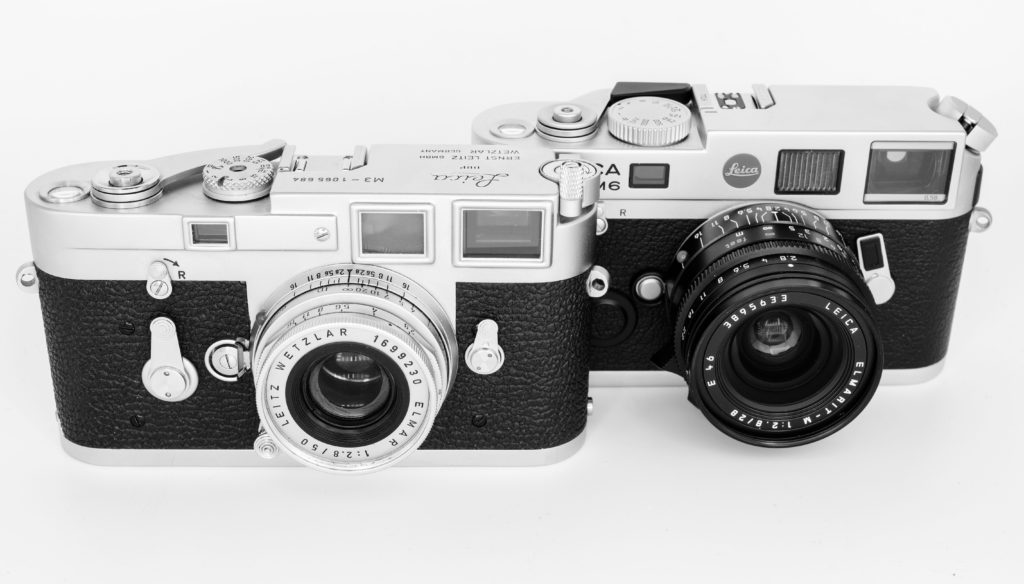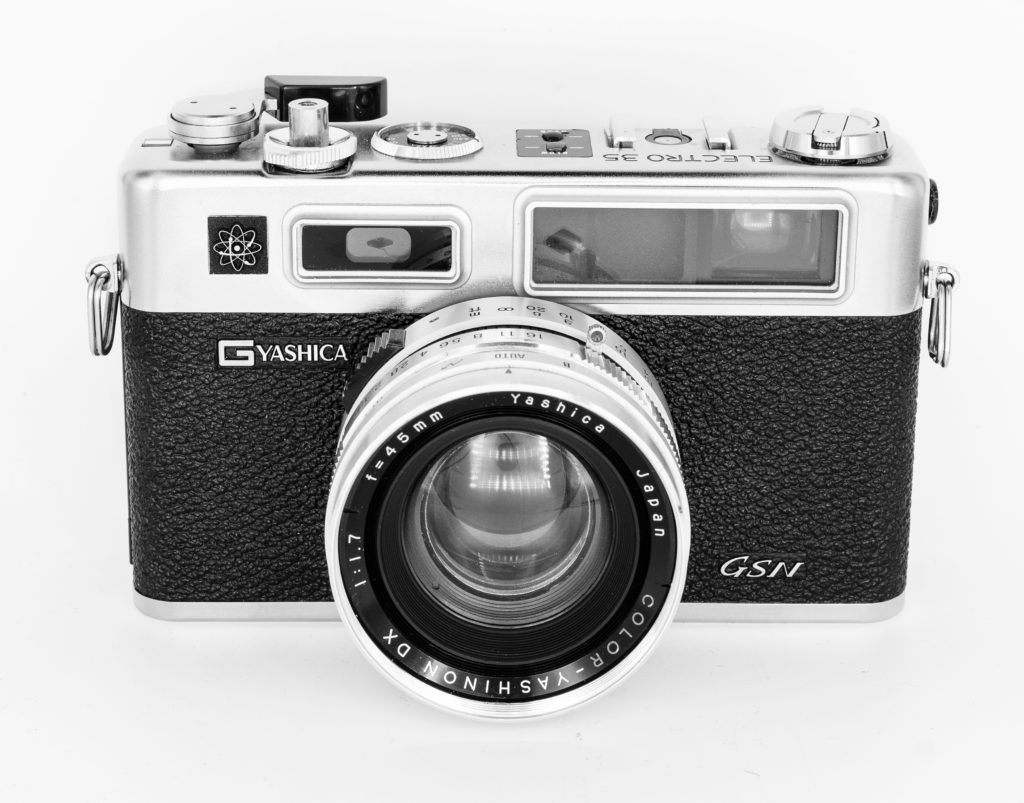The legendary German marque has had more than its fair share of movie appearances, particularly the M3. Leica pioneered the 35mm ‘miniature format’, back in 1930 with the first practical camera to use standard cinema film, which required high quality lenses and negative enlargement to make the format work.

Subsequent development, based on many years of learning, resulted in the M3 of 1954, which a huge step forward on its predecessors, combining the viewfinder and rangefinder in one bright window, a bayonet lens mount, and rapid film advance lever. Despite its high price it was very successful with over 220,000 units sold by 1966 when production ended. By that time the Nikon F, nemesis of the teutonic rangefinder, had been in the market 7 years and the world of 35mm photography had changed forever, with the SLR having won the hearts and minds of many professional photographers.
The M6 TTL
Enthusiasts continue to argue over which is the best Leica and the M3 maintains a strong fan base, mainly for its large, bright high magnification viewfinder, which many argue has never been bettered. I’ve shot with the M3, M6TTL and M7 and my personal favourite is the M6TTL (0.58 version pictured below, along with the M3) The built in light meter is eschewed by the Leica hardcore, but I find it preferable and it has superior ergonomics with a modern film crank and large dial for the shutter speed. Leica consider a film rewind crank, which has been standard on virtually all film cameras since the ’60s, to be a bit racy and like the original M3, neither film camera in production today (the Leica M-A and Leica M-P) sports one.
I came to Leica from the autofocus Q, which I travelled the world with as part of my job at the time. I am not a digital Leica M shooter, but I do love shooting with film Ms, the lenses are outstanding and full of character and the build quality is second to none. They are also very beautiful cameras and look great in the many movies they have appeared in.
The Leica M in Movies
- Persona (1966, M3)
- Downhill Racer (M3, 1969)
- Darling (M3, 1965)
- Green Berets (M3, 1968)
- Le Mans ( M3, 1971)
- Patton (M3, 1970)
- The Day of The Jackal (M3, 1973)
- The Odessa File (M3, 1974)
- Woodstock (M4, 1974)
- Dog Day Afternoon (M3, 1975)
- The Omen (M3, 1976)
- Under Fire (M4-2, 1983)
- Salvador Leica (M3, 1986)
- Wings of Desire (M4, 1987)
- Mighty Joe Young (1988, M6)
- Addicted to Love (M6, 1997)
- George of the Jungle (M6, 1997)
- Payback (M3, 1999)
- Spy Game (M6 with motor drive, 2001)
- Imposter (M6, 2002)
- We Were Soldiers (M3, 2002)
- Blood Diamond (M6, 2003)
- Eurotrip (M7, 2004)
- The Hitchhikers Guide to the Galaxy (M7, 2005)
- The Omen (M7, 2006)
Other Classic Film Cameras in Movies
A huge number of film camera manufacturers have come and gone and their products have appeared in hundreds, if not thousands of movies, but here are a few of the more notable ones. Of the models listed below, I have only shot with the Olympus OM-1, another game changing camera which began a shift towards more compact, lighter 35 mm SLRs, away from the increasing weight of the Nikon pro SLRs and back towards the smaller form factor that Leica had always delivered with rangefinders.
Though I don’t have any of the Rolleiflex models listed below (2.8F and T), I have a Rolleiflex 3.5F from 1961 which I absolutely love, and is considered by many to be one of the finest film cameras ever made. The Rolleiflex uses 120 medium format film which produces huge and very detailed 6x6cm negatives. Shooting a Twin Lens Reflex (TLR) camera is an entirely different experience to shooting either an SLR or rangefinder, and though manual focus can be challenging, gazing at the world through that illuminated ground glass screen that sees the world back to front is absolutely entrancing.

- Rear Window (Graflex Speed Graphic, 1954)
- Lolita (Agfa Isolette, Nikon S2 Rangefinder, 1962)
- From Russia With Love (Rolleiflex T, 1963)
- Bullit (Rolleiflex 2.8F, 1968)
- Jaws (Pentax Spotmatic, 1975)
- Close Encounters of the Third Kind (Rollei B35, 1977)
- National Lampoon’s Vacation (Olympus OM-1, 1983)
- Easy Money (Exacta VX, 1983)
- The Killing Fields (Rolleiflex 2.8F, Pentax Spotmatic, 1984)
- Bridges of Madison County (Nikon SP Rangefinder, 1995)
- Ronin (Leica R6.2, 1998)
- Catch me if you Can (Kodak Retina 2C, 2002)
- Harry Potter and the Half-Blood Prince (Pentax 67 medium format, 2009)
- Jurassic World (Lomography Diana F+, 2015)
- Batman v Superman (Nikon S3 Y2K Rangefinder, 2016)
- Kong: Skull Island (Canon AE-1 Program, 2017)
The Last Word
The last word in this article goes to the humble Yashica Electro 35 GSN rangefinder pictured above, a typical manual focus rangefinder camera with a fixed lens and aperture priority auto exposure mode. You simply set the aperture and if it is not correct for the lighting conditions the ‘over’ or ‘slow’ directional arrows light up.
Long after it was discontinued, the inexpensive Electro has developed a cinematic identity thanks to an appearance as Peter Parker’s camera in The Amazing Spiderman (2012). There are several Electros (G, GS, GSN, GTN, GL, MG-1 and CC) and thanks to its moment in the spotlight the GSN has become known as the Spiderman version.
In addition to being inexpensive and fun to use, the camera has highly evocative 1960s branding; the atomic ‘electronic’ symbol on the front of camera and the Color-Yashica branding on the sharp 45mm f/1.7 lens are both very 1960s indeed. Colour and electonics were both new enough to consumers when the camera was first released in 1966 to warrant being part of the branding. I have a ‘Spiderman’ myself, and whilst it’s no Leica, for value for money and fun to shoot with its hard to beat.
That’s it for my classic cameras in movies round up. If I have missed any cameras you think I should include please leave me a comment. For more about historically important cameras, please visit the year by year timeline.
Kodachrome, M4-P (2017 Netflix movie)
In Mogambo (starring Clark Gable, 1953), the character played by Donald Sinden carries a screw-mount Leica fitted with an Imarect viewfinder.
In Rear Window, Jimmy Stewart sports an Exakta.